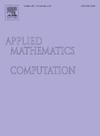Evolution of cooperation among fairness-seeking agents in spatial public goods game
IF 3.4
2区 数学
Q1 MATHEMATICS, APPLIED
引用次数: 0
Abstract
The evolution of cooperation is a pivotal area of study, essential for understanding the survival and success of complex biological and social systems. This paper investigates the dynamics of cooperation in spatial public goods games (SPGG) through a model that incorporates a fairness-driven migration mechanism. In this model, agents move towards environments perceived as fairer, influencing the spatial distribution and overall level of cooperation within the population. We examine the interplay between the time scale ratio, noise in movement, and population density. Our analysis reveals that moderate levels of movement and noise are critical for forming and maintaining cooperative clusters, while excessive movement and noise disrupt these structures, leading to reduced cooperation. Higher enhancement factors increase the resilience of cooperative behavior, extending the range of movement intensity over which high cooperation levels are maintained. Population density significantly impacts cooperative dynamics, with high-density environments promoting the coexistence of cooperators and defectors but lowering the highest achievable cooperation levels due to increased exploitation. Our findings underscore the importance of balancing movement, noise, and density to sustain cooperation and stable social structures. This research provides valuable insights for designing interventions and policies to promote cooperative behavior and social cohesion in complex populations. Future studies should further explore the adaptive mechanisms that dynamically adjust movement and strategy adaptation based on local environmental conditions.
空间公共产品博弈中寻求公平者之间合作的演变
合作的演化是一个关键的研究领域,对于理解复杂生物和社会系统的生存与成功至关重要。本文通过一个包含公平驱动迁移机制的模型,研究了空间公共物品博弈(SPGG)中的合作动态。在该模型中,个体会向被认为更公平的环境迁移,从而影响种群的空间分布和整体合作水平。我们研究了时间尺度比、迁移噪音和种群密度之间的相互作用。我们的分析表明,适度的移动和噪音对形成和维持合作集群至关重要,而过度的移动和噪音则会破坏这些结构,导致合作减少。较高的增强因子能提高合作行为的恢复力,扩大运动强度的范围,从而维持较高的合作水平。种群密度对合作动态有很大影响,高密度环境促进了合作者和叛逃者的共存,但由于剥削的增加,降低了可达到的最高合作水平。我们的发现强调了平衡运动、噪音和密度对维持合作和稳定的社会结构的重要性。这项研究为设计干预措施和政策以促进复杂种群的合作行为和社会凝聚力提供了宝贵的见解。未来的研究应进一步探索根据当地环境条件动态调整运动和策略的适应机制。
本文章由计算机程序翻译,如有差异,请以英文原文为准。
求助全文
约1分钟内获得全文
求助全文
来源期刊
CiteScore
7.90
自引率
10.00%
发文量
755
审稿时长
36 days
期刊介绍:
Applied Mathematics and Computation addresses work at the interface between applied mathematics, numerical computation, and applications of systems – oriented ideas to the physical, biological, social, and behavioral sciences, and emphasizes papers of a computational nature focusing on new algorithms, their analysis and numerical results.
In addition to presenting research papers, Applied Mathematics and Computation publishes review articles and single–topics issues.

 求助内容:
求助内容: 应助结果提醒方式:
应助结果提醒方式:


